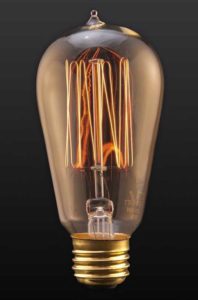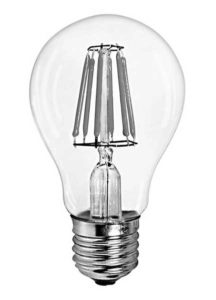Small Home Gazette, Winter 2016
New LEDs Mimic Filament Bulbs
Although federal law has now banned standard incandescent light bulbs, so-called “decorative” incandescents are still available. That category includes reproductions of late 19th and early 20th century bulbs—typically referred to as “filament” bulbs. These are bulbs that would have been used in our bungalows, and reproductions are widely available, even at The Home Depot.
There’s nothing like an old-style filament bulb to create a vintage atmosphere. They’re used extensively today in restaurants and bars to create a warm, retro look. But despite their charm, these bulbs still have many of the disadvantages of other incandescents: high energy consumption, high heat output, and short lifespan.
Back to the Future
Now, makers of LED (light-emitting diode) bulbs are attempting versions that mimic the old filament bulb type. I’m not sure how they manage to arrange the diodes into a filament-like pattern, but if you’re interested there’s a Wikipedia page (of course) that explains: http://tinyurl.com/ojy2mh4.
I recently purchased a couple of LED filament bulbs. They both try to imitate the look of the “squirrel cage” filament arrangement of the old bulbs, in which a long wire filament is zig-zagged up and down inside the glass casing. This creates a distinctive look when the bulbs are exposed, and it just screams “antique.”
The Test
I bought one LED filament bulb, made by Feit Electric, at an Ace Hardware store. The packaging claims it’s a replacement for a 60-watt bulb, though it consumes just 4 watts. It also notes that its color temperature is 2200K, which is a very “warm” color. (For reference, the recently-banned incandescent bulbs have a color temperature of about 2700K. A higher number indicates a cooler light color. Here’s an explanatory Wikipedia page: http://tinyurl.com/pt4qdxx).
I purchased another LED filament bulb on Amazon.com. It was made by BIPEE Lighting Co., and it, too, claimed to be a 60-watt replacement. Its color temperature, though, is 2700K, a bit cooler, similar to a standard household light bulb.
How did they look when lit up? They looked good.
The LED “filaments” aren’t as thin as the tungsten wire filaments of an incandescent filament bulb. But unless you had them side-by-side you wouldn’t notice.
Both bulbs cost about $13 each. The Feit bulb’s packaging says it will last for 15,000 hours (about 13 years if used three hours a day); the BIPEE package says it will last 30,000 hours.
Both bulbs are dimmable, though not all LEDs are. Note that a variety of LED filament bulbs are now available, including 40- and 25-watt equivalent versions. Check online for options, including the site 1000Bulbs.com (http://tinyurl.com/gmkynel).
Should you buy an LED filament bulb? If you have a location where the bulb will be exposed or semi-shielded, then yes, definitely. They look great, they barely sip electricity, and they’ll last a long time.














